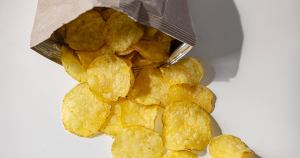We recently heard from a reader that she wished she drank soda because then she could cut it out of her diet and lose an easy 10 pounds. We feel her pain. Sometimes it’s discouraging to feel like you are doing everything “right” and the pounds still won’t come off. Perhaps, the problem is that we think we are doing everything right but what we thought was right was actually… wrong? This is what Real Food + Functional Nutritionist and bestselling author Erika Herman suggests.
Herman’s book blasts nutrition hype left and right, leaving readers with a new definition of “health” that is delicious, body-affirming, planet-friendly and liberating. She discusses why calorie-counting isn’t an accurate tool for weight loss, why dietary fat doesn’t make you fat, and why saturated fat is actually healthy, amongst many other mind-blowing revelations. If your mind isn’t blown yet, check out her 11 unexpected habits that are keeping you overweight.
Videos by PopCulture.com
Alas, calories are neither an accurate tool for measuring weight loss, nor for gauging how satiating foods are. Calories supposedly measure the amount of “energy” in a gram of food. But the body responds to different macronutrients (protein, fat and carbs), and varieties of these macronutrients, in different ways:
- Fiber runs anywhere from 0-2 calories per gram
- Sugar alcohols, like xylitol, around 2 calories per gram
- Carbs, at 4 calories per gram, won’t provide satiety and will make you want to eat more
- Protein, at 4 calories per gram, will make you feel satisfied faster and longer (in comparison to carbs), and also requires the most energy (read: calories) to digest of all macronutrients (carbs, protein, and fat)
- Fat, at 9 calories per gram, will make you feel satisfied the longest of all macronutrients and less likely to overeat than when you eat starchy carbs that just want to make you eat more at only 4 calories per gram (fat=the biggest bang for your gram)
Issues truly rooted in the body and brain’s biochemical responses to certain foods are all too often mistaken for issues of willpower (or the lack thereof). Granted, there are emotional reasons we can turn to food, but a huge factor in even emotional eating is the way we are biochemically programmed to crave and respond to certain foods.
- Rule of thumb: Fat and protein turn off the brain’s hunger button, while sugar and starch turn on the brain’s hunger button. Neutralize the allure of trigger foods by eating more fat and protein for meals. Fat and protein provide satiety, especially fat, which provides optimally sustained satiety, making you less likely to overindulge.
3. You avoid fat.
In order to enter the fat-burning zone, you must eat a fat-rich diet, with moderate protein, and source your carbohydrates mostly from low-starch veggies. A higher-fat, lower-carb diet gives the body a chance to burn stored fat instead of stored sugar. Extensive research demonstrates carbohydrate restriction combined with an increase in dietary fat leading to lower levels of circulating insulin — resulting in a higher rate of lipolysis (the burning of the body’s fat stores), and a lower rate of lipogenesis (the creation of fat stores). Sugary and starchy foods drive insulin production and therefore fat storage (yes, even fruit, brown rice and quinoa do this). (2), (3), (4)
What’s more, according to Dr. Richar Veech (who studied medicine at Harvard and earned his PhD at Oxford with Nobel Laureate Hans Krebs), “both the heart and brain run 25% more efficiently from burning fat than on… sugar.” (5)
4. You avoid foods that contain higher saturated fat.Foods that contain higher levels of saturated fat are nutrient-dense, optimally satiating, anti-inflammatory, promote weight loss by getting you into the fat-burning zone, decrease risk of degenerative diseases (i.e., heart disease and diabetes), and exhibit cancer-fighting properties. These foods include whole pasture eggs, whole-fat dairy and meat sourced from pastured/grass-fed animals, and coconut and palm oils.
- Long-chain saturated fatty acids (the kinds in meat) are the heart’s preferred nutrients (the fat around the heart is saturated fat, and when we get stressed out the heart resorts to using up its stores).
- Medium-chain saturated fatty acids (MCTs), like those found in coconut oil, feed the brain, are broken down quickly and used mainly for energy, rarely winding up as body fat.
- Saturated fat doesn’t oxidize (aka go rancid, a process that creates cancer-causing free radicals) the way unsaturated fats do (i.e., plant oils, including those from nuts, seeds, olives, avocados and even flax), saving you from using up precious antioxidants in order to neutralize free radicals lest they damage your cells.
- Furthermore, a meta-analysis of 21 studies of almost 350,000 people over 23 years demonstrates “no significant evidence for concluding that dietary saturated fat is associated with an increased risk of [coronary heart disease, stroke, and cardiovascular disease]”.
5. You avoid dietary cholesterol like it’s the plague.
Dietary cholesterol is found in nutrient-dense, fat-fighting, disease-preventive foods you should be eating regularly and without restraint. Dietary cholesterol is not bad for you; it’s necessary for good health—heart, brain, hormonal and nervous system health. Cholesterol is protective, balances hormones, and regulates brain and nervous system function—all things you want in ship-shape if you want to lose weight! Also, research reveals women with higher cholesterol live longer than women with lower cholesterol.
In reality, total cholesterol is not an accurate indicator of heart disease risk. What is important are the ratios of different kinds of cholesterol and triglycerides to one another. Furthermore, there is more than one variety of LDL (known as the “bad”cholesterol); one of those varieties (the bigger “fluffier” kind) is actually safe and healthy. Standard cholesterol test results don’t tell you the difference between different varieties of your LDL, the “good” and the “bad” LDLs.
6. You eat too many starchy and sugary foods, or drink juice, or regularly eat non-fat fro-yo.
Sugar and starch spike blood sugar and insulin levels (even if they are foods “low” on the Glycemic Index), making you more likely to gain and store fat, especially around your midsection. A low-fat diet exacerbates sugar and starch’s negative effects. Sugar and starch are digested quickly, making you feel hungry again soon after eating them. They also trigger a response in the reward center of your brain that makes you want to eat more, even if you’re not physically hungry anymore.
Focus on eating lots of low-starch colorful veggies for your carbohydrate intake. For fruit, a handful of berries is ideal. When you do eat some sugar or starch, stick with smaller portions, and serve with fat to help stabilize blood sugar and insulin.
7. You skip breakfast, or you don’t eat enough fat and protein at breakfast, but you eat too much starch/sugar.
Low-fat, low-protein breakfasts (oatmeal, cereal with low-fat milk, non-fat yogurt with fruit, bagels with low-fat cream cheese, toast and jam, etc.) set us up for rapid-cycling blood sugar highs and lows. Eat fat- and protein-rich breakfasts and you’ll be surprised how long you can go until your next meal or snack without feeling hungry. Many people who eat breakfast the right way report feeling satisfied for 6+ hours before feeling hungry again. You’ll also eat less over the course of the day, while you keep cravings at bay. Don’t make the mistake of only focusing on more protein; fat is what will keep you feeling full the longest, so don’t skimp! A mushroom, spinach, basil and cheese-stuffed omelet (made with whole pasture eggs), prepared with coconut oil or pasture butter? Yes, please! For more recipes, check out 7 High-Protein, Low-Carb Dinner Recipes and 7 High-Protein, Low-Carb Breakfast Recipes!
8. You fear salt.Salt regulates appetite, preventing you from overeating. It also regulates blood volume and pressure, the nervous system, metabolism, digestion, brain and adrenal function, and lowers risk of insulin resistance, heart disease, and premature death. Don’t restrict yourself in eating varieties of salt that are unprocessed, unrefined, unenhanced, and unfortified, including varieties of unrefined sea salt, rock salt, and pink Himalayan salt. It isn’t salt that triggers disease and makes you feel bloated. Instead, look to culprits like sugar and excess starch.9. You’re eating according to “the Mediterranean Diet.”
What we don’t realize is that our American interpretation of this traditional cuisine is misinformed. For decades we’ve been led to believe in a model of this “healthy” diet, even though it doesn’t take into account that:
- Standard dietary practices have changed as Western and industrial foods were introduced to Mediterranean regions.
- The Mediterranean covers a huge hunk of land, and traditional Mediterranean diets varied and vary greatly by region.
- In general, traditional Mediterranean diets have not included as many grains as they have unprocessed animal products, fats (usually animal-sourced), and oils.
- Cuisines in many Mediterranean regions actually include about 40 percent more sodium than the USDA tells us to eat (think of all those sodium-rich foods like olives, sardines, anchovies, prosciutto, parmesan, etc.).
10. You eat lots of whole grains because you want more fiber in your diet.
Think whole grains are loaded with fiber? Think again. Whole grains, and even legumes and beans, contain substantially more blood-sugar-and-insulin-spiking starch than fiber, making you more likely to gain weight (particularly around the midsection), or have trouble losing weight. Plus starch triggers an inflammatory response in the body which is associated with greater disease risk. Veggies are where it’s at to get lots of fiber and nutrients. Compare the following carb-to-fiber ratios for grains, legumes, and beans:
- 1 cup cooked white rice (long-grain) = 40-45g carbs : 1g fiber
- 1 cup cooked brown rice (long-grain) = 40-45g carbs : 2-4g fiber
- 1 cup cooked lentils (legumes) = 40g carbs : 16g fiber
- 1 cup black beans = 41g carbs: 15g fiber
Now compare those numbers to these of veggies:
- 1 cup broccoli (cooked) = 10g carbs: 6g fiber
- 1 cup sliced portabella mushrooms (grilled) = 6g carbs : 3g fiber
- 1 cup zucchini (cooked) = 7g carbs : 3g fiber
In general, low-starch vegetables should make up the majority of the carbs you eat.11. You avoid animal foods because you think they’re bad for you.
This couldn’t be farther from what science indicates is the case. While some commercial agriculture is inhumane and produces nutritionally and safety-compromised food products, that does not mean all animal foods are bad for you.
Plant foods do not and cannot contain Essential Fatty Acids, like EPA and DHA in balanced amounts the way they are naturally pre-formed in animal foods (wild cold-water fish, and grass-fed/pastured animal foods).What’s more, plants cannot provide the levels of essential amino acids (from protein) the human body needs. Compared to plant foods, smaller amounts of whole eggs, meats, and whole-fat dairy provide substantially higher amounts of full-spectrum essential amino acids. On the other hand, you would have to eat unrealistic amounts of plant proteins to meet the minimum daily levels of essential amino acids. And no, quinoa is not the answer: The average woman would have to eat 5½ cups of quinoa to for adequate protein and essential amino acid levels. Unfortunately, 5½ cups of quinoa also contain just shy of 200 grams of inflammatory starch, which triggers fat storage (particularly around the midsection), weight gain, and disease.
Make sure animal foods are organic and come from animals that were grass-fed/pastured. The latter farming practice makes for entirely different, excess-weight-fighting disease-preventive biological composition of the animals and their products (meat, eggs, dairy).
Some of these 11 habits are controversial to many other beliefs about what’s considered healthy in terms of complex carbs, fats, plant-based diets, and more. We would love to hear how your healthy living/eating beliefs and lifestyles compare to these declared by Erika Herman. Please share your thoughts in the comments below!
A professed Nutrition Fiend, Erika Herman is an incisive writer and researcher who holds board-certifications as a Nutritional Consultant and Holistic Health Practitioner. She authored the provocative breakout book, Eat Like a Fatass, Look Like a Goddess: The Untold Story of Healthy Foods, and runs an in-demand consulting company for Nutrition and Lifestyle Coaching, as well as industry-related Marketing, Branding, and Communications. Erika and her work have been featured in the likes of Redbook, Yahoo!, SheKnows, Mamavation, and Intent. Learn more about Erika at www.eatlikeagoddessbook.com





